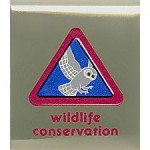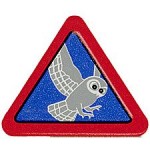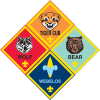Belt Loop
Complete these three requirements
- Explain what natural resources are and why it’s important to protect and conserve them.
- Make a poster that shows and explains the food chain. Describe to your den what happens if the food chain becomes broken or damaged.
- Learn about an endangered species. Make a report to your den that includes a picture, how the species came to be endangered, and what is being done to save it.
Academics Pin
Earn the Wildlife Conservation belt loop and complete five of the following requirements.
- Visit a wildlife sanctuary, nature center, or fish hatchery.
- Collect and read five newspaper or magazine articles that discuss conservation of wildlife and report to your family or den what you learn.
- Learn about five animals that use camouflage to protect themselves. Tell your den or an adult family member what you learned.
- Make a birdbath and keep a record for one week of the different birds that visit it.
- Make a collage of animals that are in the same class: fish, amphibians, reptiles, birds, or mammals.
- Make a plaster cast of an animal track. Show it to your den.
- With your parent or adult partner, visit with a person who works in wildlife conservation, such as a park ranger, biologist, range manager, geologist, horticulturist, zookeeper, fishery technician, or conservation officer.
- Visit a state park or national park.
- Participate in an environmental service project that helps maintain habitat for wildlife, such as cleaning up an area or planting trees.
Additional Information
Ways to Make a Difference!
- Put out nesting materials for birds, such as short pieces of yarn, string, or dried tall grasses.
- Place a birdbath in your yard. Keep it clean and filled with fresh water.
- Put out a bird feeder, or several feeders that have different foods for different kinds of birds.
- Make or buy a hummingbird feeder.
- Build a bat house. One small brown bat can eat 600 mosquitoes an hour!
- Grow flowering plants such as asters, zinnia, or milkweed to provide nectar for butterflies.
- Leave standing dead and dying trees in an area unless they pose a hazard to humans or property. Dead, dying, and hollow trees and logs on the ground provide homes for many species of wildlife.
- Write letters to newspapers or local government representatives on environmental issues.
The Balance of Nature
Conservation of wildlife is important because of the idea of the balance of nature.Animals, plants, and their habitats are connected through an environment that supplies them with what they need to live. This is called an ecosystem. The ecosystem is balanced when all the parts of the community are present: animals are able to find food and have healthy young.
If you lose a part of the balance, the entire system can suffer. For instance, in some parts of the country, people thought that wolves threatened their livestock, so they killed the wolves. But without these predators, the population of deer increased too quickly. In new housing developments, you now can see deer grazing in people’s backyards and eating shrubs and flowers. The deer also don’t have as much natural habitat because of all the buildings.
You are part of the balance of nature too. Think of how you are a part of your ecosystem, and what you can do to help preserve it
Resources
Visit the library, a natural history museum, a game preserve, and any federal, state, and local agencies involved in fish and game and wildlife conservation.
Wildlife Forever
2700 Freeway Blvd. #1000
Brooklyn Center, MN 55430
Phone: 763-253-0222; fax: 763-560-9961
Web site: http://www.wildlifeforever.org
U.S. Fish and Wildlife Service
Department of the Interior
Room 3445
1849 C St., NW
Washington, DC 20240
Phone: 1-800-344-WILD
Web site: http://www.fws.gov
U.S. Environmental Protection Agency
Ariel Rios Building
1200 Pennsylvania Ave., NW
Washington, DC 20004
Web site: http://www.epa.gov
U.S. Forest Service Natural Resources and Conservation Education Program
Web site: http://www.fs.fed.us/outdoors/nrce
The Conservation Education(CE) program helps people of all ages understand and appreciate our country’s natural resources and how to conserve those resources for future generations.
National Wildlife Federation Backyard Wildlife Habitat Program
11100 Wildlife Center Drive
Reston, VA 20190-5362
Phone: 1-800-822-9919
Web site: http://www.nwf.org
The National Wildlife Federation began the Backyard Wildlife Habitat program in 1973 to acknowledge and encourage individuals who garden for the benefit of wildlife






